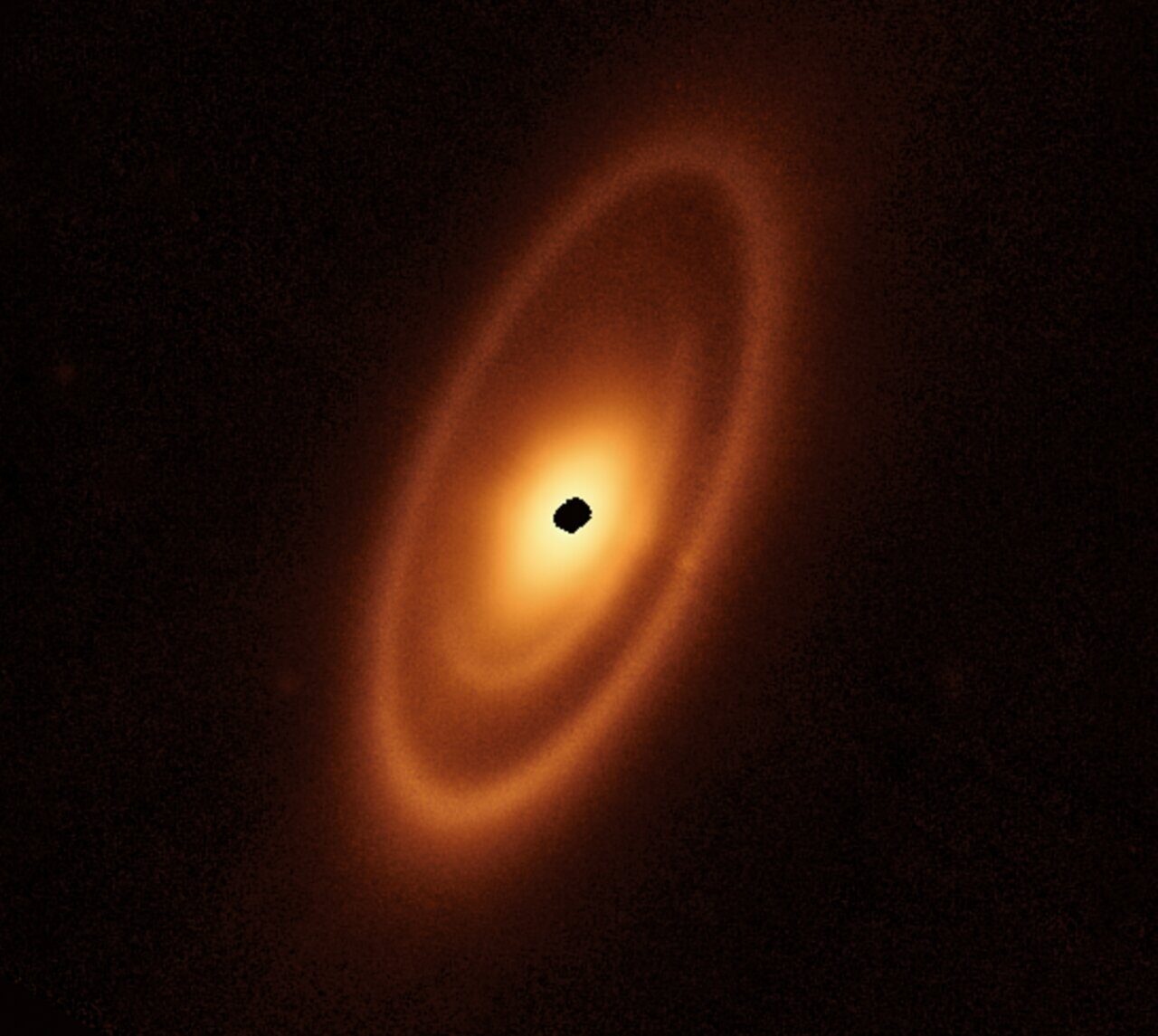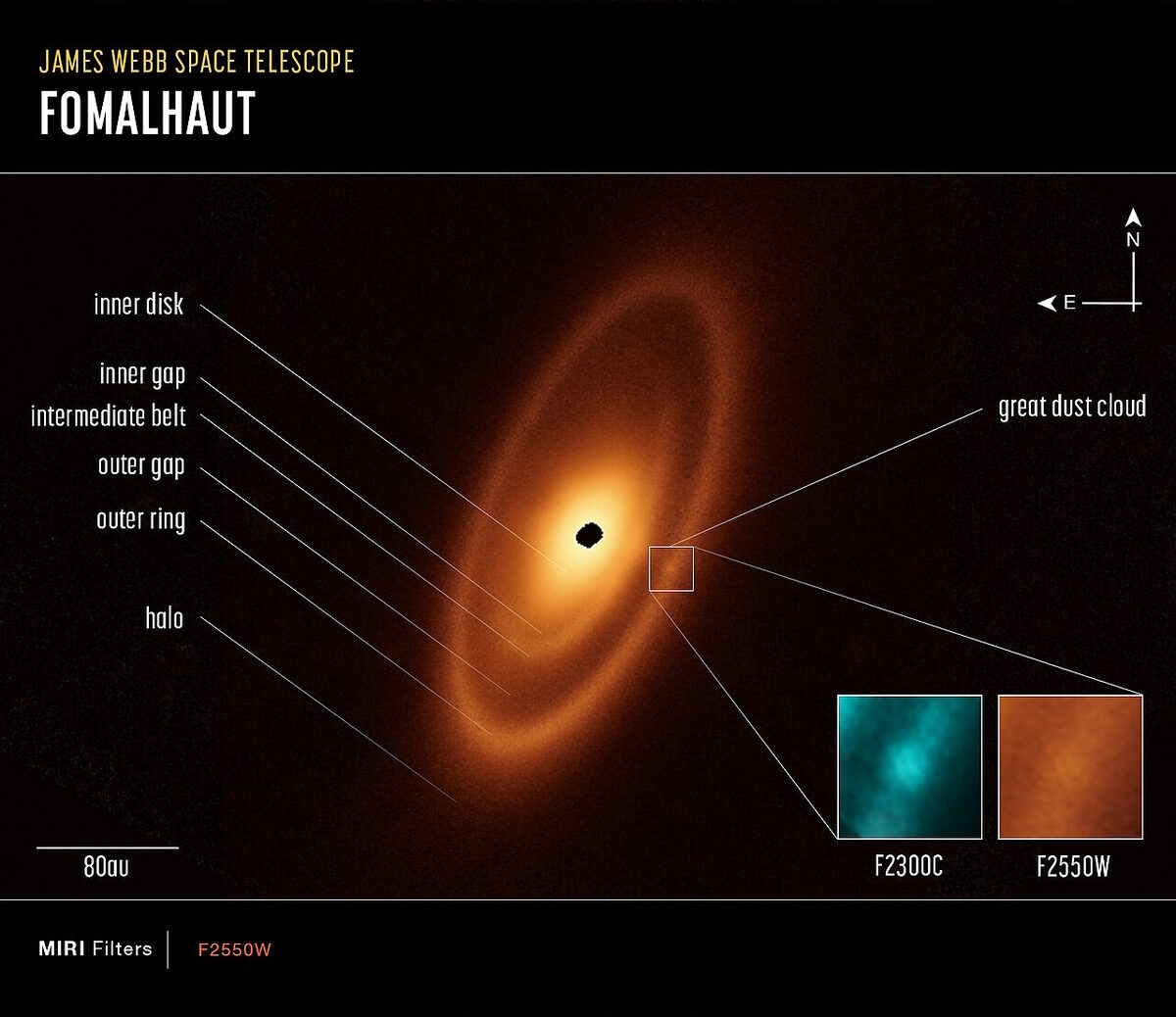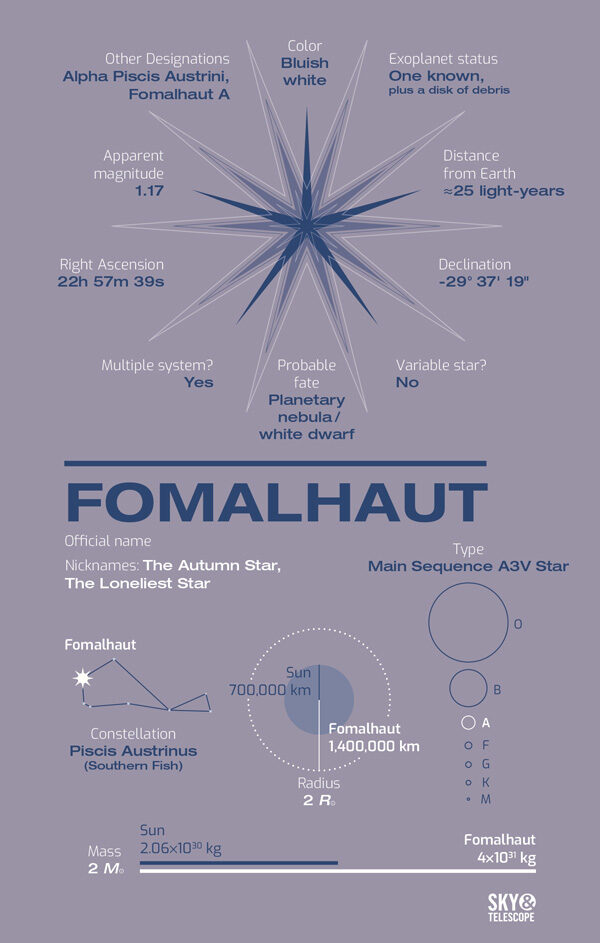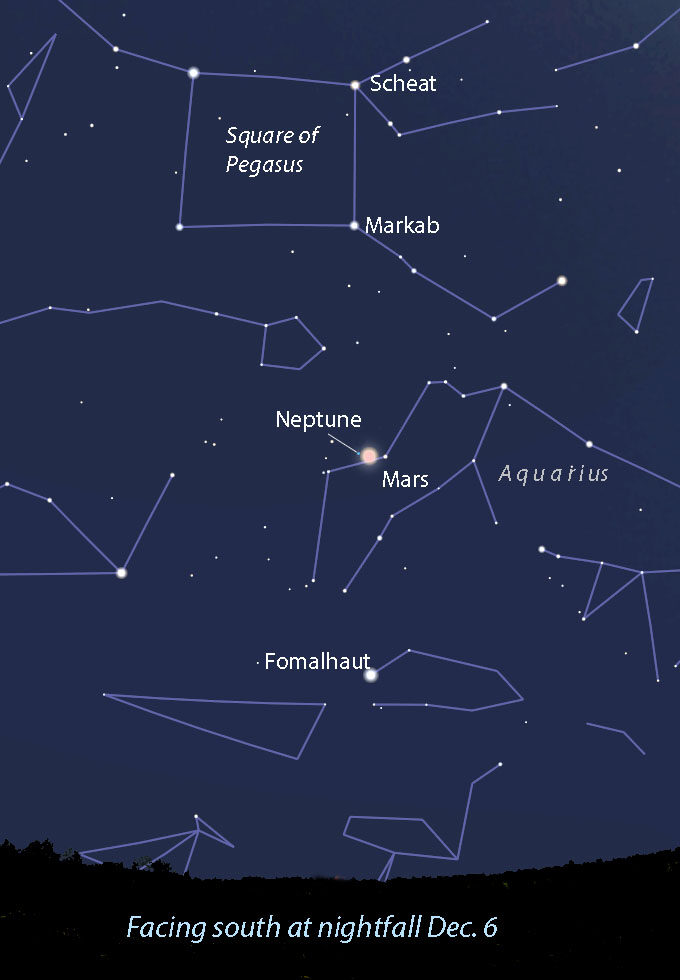
Fomalhaut, a bright, young star 25 light-years away in the constellation Piscis Austrinus, illuminates a disk of planet-forming debris. Such debris disks contain clues about exoplanets and even smaller bodies that would otherwise remain hidden.
András Gáspár (University of Arizona) and his team present in Nature Astronomy images of the Fomalhaut system taken by the Mid-Infrared Instrument (MIRI) aboard the James Webb Space Telescope (JWST). The images reach a resolution and sensitivity far beyond the capability of earlier instruments. The team also analyzed new images taken by Hubble's Space Telescope Imaging Spectrograph, in which the star's light is blocked using a coronagraph.
Previously, Hubble, the Spitzer Space Telescope, and other telescopes have shown a far-out debris ring surrounding Fomalhaut that's akin to the Kuiper Belt in our solar system. Analysis of the system's brightness at different wavelengths had also suggested the presence of a dusty inner disk. Now, the new JWST images reveal unprecedented detail, including a new belt inside the first, an extended inner disk, and a gap between the two. They also show what might be a dust cloud in the outer, previously detected ring.
"My first thought was: 'Wow!'," remarks Samantha Lawler (University of Regina, Canada), who wasn't involved in the study. "I spent a lot of time imagining possible orbital configurations for this system, so I was super-excited to see these detailed JWST images showing new belts and a new dust cloud."
The innermost belt of dust the researchers discovered is analogous to the asteroid belt in our own solar system, but it's much more extended than previously thought. Farther out, a gap is followed by an "intermediate belt" — these are both new discoveries. An as-yet-unseen exoplanet might have carved out the gap, and might continue to shepherd the belt, much as Jupiter's gravitational effects shape our asteroid belt.

Alternatively, "it may well be a background galaxy," Gáspár points out. "A follow-up observation will allow us to easily tell; if it's part of the ring, it will co-rotate and likely expand in size."
The putative dust cloud is reminiscent of another feature, Fomalhaut b, that astronomers had previously mistaken for an exoplanet candidate. Decades of observations ended up discounting the planet hypothesis, as the feature dissipated over time. The JWST observations are consistent with it being instead another collision-made dust cloud. The intermediate debris belt provides an additional source of material for collisions; moreover, it's misaligned with the outer belt, increasing the odds of planetesimals going astray.
The overall picture that emerges is of a dynamic system that's changing as we watch it. As Lawler puts it, "Maybe collisions between asteroids are common enough in this very close, very bright system that there are dust clouds constantly being created in collisions, expanding, and fading." The belts of debris orbiting Fomalhaut may be the site of regular, explosive collisions, with icy and rocky bodies routinely crashing into each other, throwing up billowing clouds of dust. More observations will enable astronomers to confirm whether the "Great Dust Cloud" lives up to its name, as events unfold.
"Some of the next steps include testing whether the new blob that overlaps with the disk is actually a dust cloud in the system, or a background object, and seeing if we can find the hidden planets that the various disk features appear to point towards," comments Markus Janson (Stockholm University), who also was not part of the study.
Lawler poses some other questions raised by the study: "How will the 'Great Dust Cloud' change? Will it also expand and fade away as Fomalhaut b did? Will new dust clouds appear from other collisions?" Computer modeling, she adds, can help astronomers narrow down the orbits and masses available to any exoplanets that might exist in the system.
Training JWST on the Fomalhaut system has already unearthed a tranche of secrets. "The level of detail is amazing," says Janson. "There is no other telescope that can come even close to that performance." More details lie tantalizingly within reach.
Meet Fomalhaut
Fomalhaut — often pronounced FO-MA-LO — is one of those bright stars that appears vivid in our skies due to its close proximity to our home planet. At a mere 25 light-years away, Fomalhaut is among the Sun's closest stellar neighbors. Though Fomalhaut is in the main sequence and only a bit larger than the Sun, the star produces considerably more energy in the visible light spectrum, shining with a luminosity around 16 times that of the Sun. If you could stand near Fomalhaut and look back at our Sun, the resulting view would be more disappointing than the one we experience looking at Fomalhaut.
Besides luminosity, another significant difference between the two is that while the Sun is a lone star, Fomalhaut is the brightest member of a multiple star system. Fomalhaut A — as the main star is labeled — is gravitationally joined at a distance of about 0.9 light-years to Fomalhaut B, a variable K-type main sequence star a little smaller than the Sun and quite faint from our vantage point, just under 13th magnitude. Yet another member of the system, Fomalhaut C, is a red dwarf separated from Fomalhaut A by about 2.5 light-years. From our view, that translates into 5.7°, or the width of about 11 full moons! Fomalhaut C was only recently recognized as a member of Fomalhaut's system. It actually resides within the constellation Aquarius, while the other two members sit in Piscis Austrinus — a good lesson in how man-made cataloging schemes don't always match up precisely with nature.
Adding to the intrigue is Fomalhaut A's suspected planetary companion, Fomalhaut b (not to be confused with the capitalized Fomalhaut B, the star). In 2014, in a public outreach campaign, the IAU selected Dagon as Fomalhaut b's proper name. The planet and its associated debris disk circle Fomalhaut A in a highly elliptical orbit; this combined with Dagon's distance from its home star means that it takes the planet a staggering 1,700 years to complete a circuit. Take a moment to consider that orbital period; the last time Dagon was in its current position was around the 4th century AD, when Constantine the Great was emperor of Rome. By comparison, Pluto (also with an elliptical orbit) completes a trip around the Sun in a comparatively short 248 years.
Origin / Mythology
While probably not as famous as the zodiacal Pisces (the Fishes), Piscis Austrinus (the Southern Fish) is nevertheless closely associated with the more familiar constellation Aquarius, who is traditionally depicted as pouring out a vessel of water onto the Southern Fish. The concept of Piscis Austrinus as a fish would seem to be a very ancient and widespread idea. The name Fomalhaut is Arabic for "fish's mouth" or alternatively "whale's mouth," a concept later shared by the Greeks. The Babylonians and Egyptians each had variations on a tale that this fish rescued an important mythological character. Finally, Fomalhaut was known as one of the four "royal stars."





Reader Comments
to our Newsletter